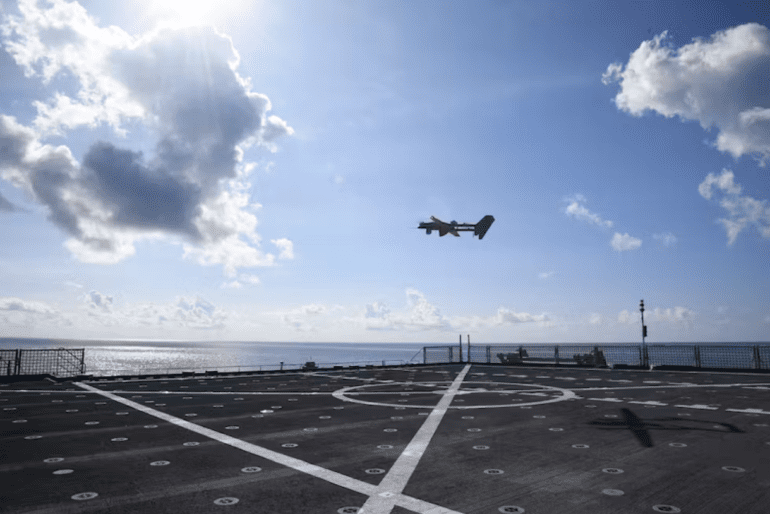- The Navy is shifting its procurement strategy to prioritize sensors and systems over the aircraft itself for AI-enabled unmanned cooperative combat aircraft (CCA).
- Rear Adm. Stephen Tedford unveiled plans at Sea-Air-Space 2024 to synchronize unmanned fleets with the military’s sixth-generation crewed aircraft systems.
- Both the Air Force and Navy aim to deploy unmanned fleets within the decade, focusing on rapid upgrades to keep pace with evolving technology and threats.
- The Navy seeks to minimize costs by treating the CCA fleet as consumable assets, with a target per-aircraft cost below $15 million.
- The development will prioritize sensors and systems over aircraft, with an analysis study planned for 2025 to explore integral technologies.
- Emphasis is placed on fortifying command-and-control infrastructure and advancing navigation systems for autonomous aircraft.
- The Navy closely monitors the Air Force’s progress in CCA innovation and aligns with the Pentagon’s vision of unified command and control.
- The Air Force leads in establishing government reference architecture standards for AI and autonomy within the CCA program.
Main AI News:
In a strategic shift, the Navy aims to overhaul its acquisition and maintenance approach for AI-enabled unmanned cooperative combat aircraft (CCA), prioritizing sensors and systems over the aircraft itself.
Rear Adm. Stephen Tedford, program executive officer for Unmanned Aviation and Strike Weapons, delivered a keynote address at Sea-Air-Space 2024, unveiling the Navy’s ambitious plans for its next-generation drones. Emphasizing collaboration with the military’s forthcoming sixth-generation crewed aircraft systems, Tedford outlined the vision for a synchronized unmanned fleet. Correspondingly, the Air Force is forging ahead with its own collaborative combat aircraft initiative.
With aspirations to deploy unmanned fleets within this decade, Tedford articulated a departure from traditional sustainment models, favoring agility and cost-efficiency. Eschewing long-term sustainment programs, the focus lies on swift fleet upgrades to keep pace with evolving technology and emerging threats.
“We’re endeavoring to revolutionize our approach to CCAs,” remarked Tedford. “Instead of extensive lifespans, we envision a platform that facilitates rapid advancements and upgrades, aligning with the trajectory of unmanned technology and threat landscapes.”
Challenging historical conventions, Navy leadership aims to mitigate exorbitant costs associated with individual platforms, targeting a per-aircraft cost below $15 million. This paradigm shift renders the CCA fleet akin to consumable assets, enabling flexible deployment strategies.
While the “A” in CCA denotes aircraft, the Navy prioritizes the development sequence, commencing with sensors and systems. An analysis study slated for 2025 will spearhead technology exploration integral to the CCA program’s evolution.
With a steadfast commitment to bolstering command-and-control infrastructure, Navy officials underscore the imperative of fortifying the fleet’s cybersecurity posture. Concurrently, advancements in navigation and positioning systems for autonomous aircraft remain a focal point.
Closely monitoring the Air Force’s strides in CCA innovation, the Navy aligns with the Pentagon’s vision of unified command and control, integrating systems across domains seamlessly.
Highlighting the Air Force’s leadership in shaping government reference architecture standards for AI and autonomy, Tedford emphasizes the importance of a universal, interdependent, and interchangeable approach to technology adoption within the CCA fleet.
Through these concerted efforts, the Navy charts a course towards a transformative procurement model, underpinned by agility, cost-effectiveness, and technological supremacy.
Conclusion:
The Navy’s strategic shift towards prioritizing sensors and systems over aircraft in unmanned fleet procurement signifies a move towards greater agility, cost-efficiency, and technological readiness. This approach underscores the importance of adaptability and innovation in navigating evolving market dynamics, paving the way for enhanced military capabilities and potentially influencing procurement strategies across the defense industry.

